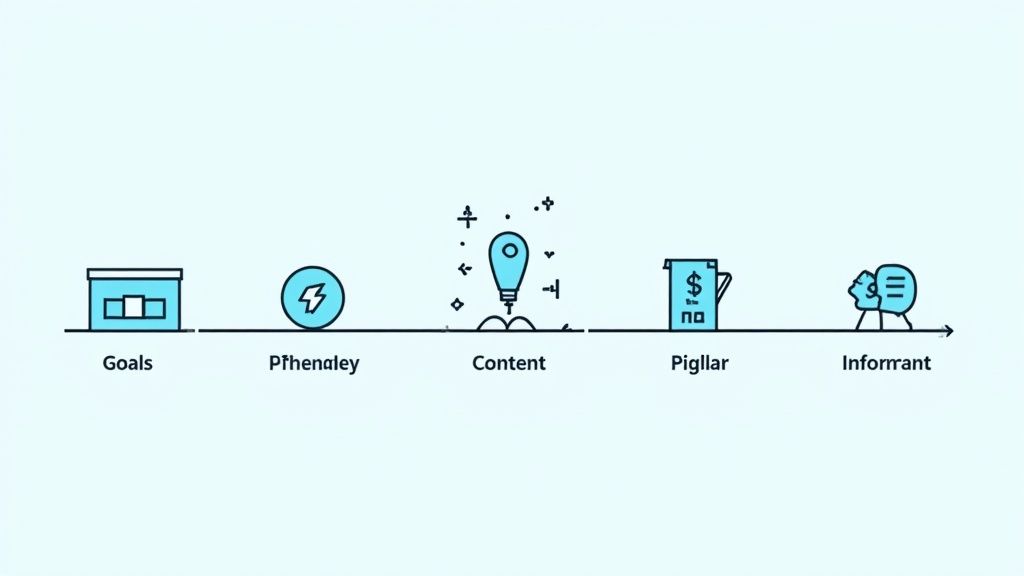9 Content Marketing Best Practices for 2025

Beyond the Buzz: Mastering Content That Actually Converts
In the competitive digital ecosystem, the old saying 'content is king' has transformed from a simple catchphrase into a complex, data-driven science. Merely producing a steady stream of articles or social media posts is no longer a viable strategy. True success now depends on strategic execution, where every piece of content is meticulously planned and serves a specific purpose. The core challenge for modern brands isn't just gaining visibility; it's being remembered, trusted, and compelling enough to inspire action.
Many businesses find themselves trapped in a frustrating cycle, investing significant resources into content that ultimately fails to resonate, generate meaningful traffic, or positively impact their bottom line. This guide is designed to break that cycle. We are moving beyond generic advice to provide a strategic blueprint built on proven content marketing best practices. Each of the principles outlined here is designed to be immediately actionable, helping you transform your content program from an unpredictable expense into a reliable engine for sustainable growth.
This listicle will provide a comprehensive roadmap to mastering content that performs. We will explore how to:
- Develop a deep, empathetic understanding of your audience.
- Construct a resilient and adaptable content strategy.
- Focus on creating high-value assets over high-volume noise.
- Measure what truly matters for continuous improvement.
By implementing these frameworks, you can ensure every blog post, video, and social update you create works systematically to boost your SEO performance, captivate your audience, and elevate your brand's authority in the market. Let’s dive into the practices that separate high-impact content from the noise.
1. Know Your Audience Inside and Out
The cornerstone of all effective content marketing best practices is a profound understanding of your audience. This goes far beyond basic demographics. It involves creating detailed buyer personas based on data, not assumptions, to map out your audience’s specific pain points, professional challenges, content preferences, and decision-making triggers. This foundational step ensures that every piece of content you create, from a blog post to a video tutorial, is engineered to resonate deeply and personally with the right people.

When you know precisely who you are talking to, you can move from broadcasting generic messages to having meaningful conversations. This data-backed empathy guides your entire strategy, influencing topic selection, tone of voice, content format, and distribution channels. The goal is to make your audience feel seen and understood, which is the first step toward building trust and lasting brand loyalty.
How to Implement This Practice
A successful audience-first approach relies on continuous research and refinement. Instead of creating personas once and forgetting them, treat them as living documents.
- Gather Diverse Data: Combine quantitative data from Google Analytics (demographics, on-site behavior) with qualitative insights from customer surveys, sales team feedback, social media listening, and one-on-one interviews.
- Develop Detailed Personas: Create 3-5 core buyer personas. Give each a name, a job title, goals, and frustrations. For example, a B2B software company might have "Marketing Manager Mary," who is overwhelmed by data, and "Startup Founder Steve," who needs scalable, budget-friendly solutions.
- Map Content to the Journey: Align specific content pieces with different stages of your persona's buyer journey. An awareness-stage blog post for Mary might be "5 Ways to Simplify Your Marketing Reporting," while a decision-stage case study would show how your software solved her exact problem for a similar company.
- Update and Validate: Revisit and update your personas quarterly. Use A/B testing on headlines, calls to action, and email subject lines to validate your assumptions about what resonates with your audience.
By implementing these steps, you ensure your content strategy is not just a creative exercise but a precision-targeted engine for engagement and growth. A great example is Mailchimp, which focuses its content exclusively on the struggles and aspirations of small business owners, providing actionable guides and resources that directly address their audience's core needs.
2. Create a Comprehensive Content Strategy
Without a clear plan, content creation becomes a series of disjointed tactics rather than a cohesive strategy driving business growth. One of the most critical content marketing best practices is developing a formal content strategy that acts as a blueprint for every decision. This document aligns your content efforts with specific business objectives, defining what you will create, for whom, where it will be published, and how its success will be measured. It transforms content from an expense into a measurable asset.

A robust strategy, as championed by pioneers like Joe Pulizzi, ensures consistency and purpose. It prevents random acts of content and instead builds a deliberate ecosystem where each piece contributes to a larger goal, such as building authority, generating leads, or supporting customer retention. Brands like American Express with its OPEN Forum for small businesses exemplify this, creating a go-to resource that builds immense brand equity by consistently addressing a specific audience's needs. If you need additional guidance, you can find a wealth of information on developing a robust content strategy to help you get started.
How to Implement This Practice
Building an effective content strategy requires a structured approach that connects high-level goals with day-to-day execution. It's a living document that should guide your team's efforts and evolve with your business.
- Establish SMART Goals: Start by defining goals that are Specific, Measurable, Achievable, Relevant, and Time-bound. Instead of "increase traffic," aim for "increase organic blog traffic by 20% in the next six months by targeting long-tail keywords."
- Define Core Content Pillars: Identify 3-5 central themes or "pillars" that directly support your brand's value proposition and align with your audience's primary interests. These pillars will be the foundation for all your topic ideation and content creation.
- Plan with a Content Calendar: Map out your content production schedule 3-6 months in advance. A shared calendar provides visibility, ensures a consistent publishing cadence, and helps manage resources effectively.
- Allocate for Experimentation: Dedicate around 20% of your content budget and resources to experimenting with new formats, channels, or topics. This allows you to innovate and discover new opportunities for engagement without disrupting your core strategy.
- Review and Adapt Quarterly: Your strategy isn't static. Set aside time each quarter to review performance data against your goals. Use these insights to refine your approach, double down on what works, and pivot away from what doesn't. You can learn more about creating a content strategy to further refine your process.
3. Focus on Quality Over Quantity
In an online world saturated with content, the most effective strategy is to pivot from volume to value. This content marketing best practice involves concentrating your resources on creating fewer, but exceptionally high-quality, pieces of content. Instead of churning out daily blog posts to meet a quota, you invest in producing comprehensive, well-researched, and impeccably presented assets that establish authority, build trust, and deliver genuine solutions to your audience's problems.

This approach, popularized by thought leaders like Brian Dean with his "Skyscraper Technique," argues that a single, definitive piece of content can generate more traffic, backlinks, and long-term engagement than dozens of superficial articles combined. By focusing on quality, you create evergreen resources that serve your audience for years, continuously driving organic traffic and solidifying your brand's reputation as a go-to expert in your niche.
How to Implement This Practice
Shifting to a quality-first mindset requires a strategic change in how you plan, create, and invest in content. It is less about a content calendar and more about a content portfolio.
- Invest in Production Value: Allocate budget for professional editing, graphic design, and even custom illustrations or photography. A polished presentation signals credibility and enhances the user experience, making complex information easier to digest.
- Generate Original Insights: Go beyond summarizing existing information. Conduct your own surveys, analyze proprietary data, or interview subject matter experts to offer a unique perspective that can't be found elsewhere. This makes your content highly linkable.
- Aim for Definitive Coverage: Create "pillar pages" or ultimate guides that cover a topic so thoroughly that the reader has no need to look for other sources. Your goal is to become the best result on the search engine results page.
- Prioritize Evergreen Topics: Focus on foundational topics that will remain relevant and valuable to your audience over the long term. This maximizes the return on your initial time and resource investment.
- Repurpose Strategically: Leverage your high-quality cornerstone content by breaking it down into smaller assets. A comprehensive guide can become an infographic, a video series, a webinar, and multiple social media posts, extending its reach and impact across different channels.
Brands like Moz exemplify this with their in-depth Whiteboard Friday series and exhaustive SEO guides. Each piece is a masterclass in its topic, making it an indispensable resource for digital marketers and a powerful engine for organic growth and brand loyalty.
4. Optimize for Search Engines (SEO)
Content marketing and SEO are not separate disciplines; they are two sides of the same coin. Truly effective content marketing best practices require that every piece of content is created with search engine visibility in mind. This means building your content on a foundation of strategic SEO, from keyword research and user intent analysis to on-page optimization and technical integrity. The goal is to create content that both search engine crawlers and human readers can easily find, understand, and value.
When you strategically optimize your content, you are not just trying to rank higher; you are ensuring it reaches the right audience at the moment they are actively seeking solutions. This process transforms your content from a passive asset into a powerful, inbound lead-generation machine. By aligning your insights with what people are searching for, you attract qualified traffic, build authority in your niche, and generate sustainable organic growth long after the content is published.
How to Implement This Practice
Integrating SEO into your content workflow is a systematic process that marries data with creativity. It ensures your content is discovered and delivers a superior user experience.
- Prioritize Search Intent: Move beyond simply targeting high-volume keywords. Use tools like Ahrefs or SEMrush to analyze the top-ranking pages for your target query. Understand if users are looking for informational guides (blog posts), navigational pages (homepages), or transactional options (product pages), and create content that matches that intent.
- Build Topic Clusters: Organize your content around central "pillar pages" that cover a broad topic extensively. Support these pillars with shorter, more specific "cluster" blog posts that link back to the main pillar. This structure, popularized by strategists like Brian Dean, signals your expertise on a topic to search engines and improves internal linking.
- Optimize On-Page Elements: Ensure every piece of content includes the target keyword in the title tag, meta description, URL, and at least one H1 or H2 heading. Use structured data (schema markup) to help search engines understand your content better and increase your chances of earning a featured snippet.
- Monitor and Refresh: SEO is not a one-time task. Regularly monitor your content's performance using Google Search Console. Identify pages with declining traffic or rankings and update them with fresh information, new data, and improved optimization to maintain their value and visibility. Ahrefs, for example, excels by creating comprehensive guides that not only rank well but also serve as the definitive resource for SEO-related searches.
5. Diversify Content Formats and Channels
Relying on a single content format, like blog posts, is a missed opportunity in today's multi-platform world. A core tenet of modern content marketing best practices is to diversify your content into multiple formats and distribute it across various channels. This strategy recognizes that your audience consumes information differently; some prefer watching a short video, others listen to podcasts during their commute, and many still value in-depth written guides. Diversifying maximizes your reach and caters to these varied preferences, ensuring your message lands effectively, regardless of the platform.

This approach isn't about creating more work; it’s about working smarter by repurposing core ideas. A single comprehensive research report can be transformed into a webinar, an infographic, a series of social media posts, a podcast episode, and several short-form videos. This maximizes the ROI of your initial content creation effort while reinforcing your brand’s authority across the digital ecosystem. It allows you to meet your audience where they are most active, building a more robust and resilient brand presence.
How to Implement This Practice
A successful multi-format strategy is built on strategic repurposing and channel-specific optimization. It’s about adapting a core message, not just copy-pasting it across platforms.
- Adopt a Pillar Content Model: Start with a substantial piece of "pillar" content, like an ultimate guide or an in-depth webinar. Then, break it down into smaller, "cluster" content assets. A webinar, for example, can be repurposed into blog posts, quote graphics for Instagram, short video clips for TikTok, and an audio version for a podcast. Explore these proven content repurposing strategies to boost ROI to get started.
- Match Format to Channel: Tailor your content format to the strengths of each platform. LinkedIn is ideal for professional articles and carousels, while Instagram and TikTok thrive on visually engaging Reels and Stories. Keeping abreast of current trends, such as the Top 9 Short Form Video Trends, can help you diversify your content effectively.
- Maintain Brand Consistency: While the format and tone may adapt slightly from channel to channel, your core brand voice, messaging, and visual identity must remain consistent. This cohesion builds a unified brand experience that audiences can recognize and trust, no matter how they discover you.
- Track Channel-Specific Metrics: Measure what works for each format and channel. Track video view duration on YouTube, engagement rates on social media, and download numbers for your podcast. Use this data to refine your distribution strategy and double down on the formats that resonate most powerfully with your audience.
An excellent example is HubSpot, which seamlessly integrates its blog, YouTube channel, and podcast network. Each platform offers unique value while driving traffic to the others, creating a powerful, interconnected content ecosystem that captures and nurtures leads from every corner of the internet.
6. Maintain Consistency in Publishing
One of the most powerful yet often overlooked content marketing best practices is the disciplined commitment to a consistent publishing schedule. This means establishing a reliable cadence for your content, whether it's a daily blog post, a weekly video series, or a bi-weekly newsletter. Consistency builds anticipation and turns casual readers into a loyal audience that actively expects and looks forward to your next piece. It signals reliability and authority, conditioning both your audience and search engine algorithms to see you as a dependable source of information.
When your audience knows when to expect new content, you embed your brand into their routine. This habit-forming approach is crucial for cutting through the digital noise. Furthermore, search engines like Google favor websites that are updated regularly with high-quality content, seeing it as a sign of an active and relevant site. This steady stream of content creates more opportunities for ranking, more pages to index, and a continuous flow of signals that boost your domain authority over time.
How to Implement This Practice
Sustaining a consistent publishing rhythm requires planning and a system, not just last-minute effort. The key is to remove the daily pressure of creation through strategic foresight.
- Build a Content Calendar: Use tools like CoSchedule, Trello, or a simple spreadsheet to plan your content at least 4-6 weeks in advance. This calendar should map out topics, formats, authors, and publishing dates.
- Embrace Content Batching: Dedicate specific blocks of time to similar tasks. For example, spend one day outlining four blog posts, another day writing them, and a third day creating all the associated social media graphics. This is far more efficient than starting from scratch every day.
- Establish Quality Standards: Define a "minimum viable quality" level for your content. This ensures that even during busy periods, you can publish content that meets your brand standards without striving for unattainable perfection on every single piece.
- Create a Content Buffer: Work ahead to build a reserve of ready-to-publish content. Having 2-4 weeks of content completed and scheduled provides a crucial safety net, ensuring your schedule remains uninterrupted by unexpected delays, holidays, or creative blocks.
By systemizing your production, you transform content creation from a reactive scramble into a proactive, sustainable process. A prime example is Copyblogger, whose founder Brian Clark built its authority through a relentless, decade-plus commitment to daily publishing, proving that consistency is a cornerstone of building a content empire.
7. Leverage User-Generated Content and Community Building
One of the most authentic and powerful content marketing best practices is to shift the spotlight from your brand onto your customers. Leveraging user-generated content (UGC) and building a vibrant community turns your audience from passive consumers into active brand advocates. This strategy involves encouraging, curating, and amplifying content created by your actual users, such as reviews, photos, videos, and testimonials. It’s about building trust through social proof, not self-promotion.
When potential customers see real people celebrating your product or service, it carries more weight than any polished ad campaign ever could. This approach fosters a sense of belonging and transforms your brand into a hub for shared interests and experiences. By creating spaces for your community to connect and share, you build a loyal following that is emotionally invested in your success, leading to sustained engagement and organic growth.
How to Implement This Practice
A successful UGC and community strategy is built on empowerment and recognition. It requires creating a framework that makes it easy and rewarding for your audience to contribute.
- Launch a Branded Hashtag Campaign: Create a simple, memorable hashtag and encourage customers to use it when sharing their experiences on social media. GoPro’s #GoPro hashtag is a masterclass, turning customers into a global network of adventure storytellers.
- Feature Customers Prominently: Regularly showcase the best UGC on your official channels, whether it's on your website homepage, in email newsletters, or across social media. Airbnb excels at this by amplifying host and guest stories, making their community the hero of their brand narrative.
- Build a Dedicated Community Hub: Create a dedicated space for your audience to connect, such as a Facebook Group, a Discord server, or a branded forum. This gives your most enthusiastic fans a place to interact with each other and your brand directly, fostering deeper relationships.
- Provide Clear Incentives and Guidelines: Motivate participation by offering incentives like discounts, prizes, or exclusive access. To fully leverage this, it's beneficial to understand specific formats like a deeper dive into UGC video. Always provide clear guidelines on what kind of content you’re looking for to ensure quality and brand alignment.
8. Measure Performance and Optimize Based on Data
Creating great content is only half the battle; the other half is understanding its impact. One of the most critical content marketing best practices is to rigorously measure performance and use that data to drive your strategy forward. This involves moving beyond vanity metrics like page views and focusing on Key Performance Indicators (KPIs) that directly link to business goals. A data-driven approach transforms content marketing from a creative guessing game into a predictable, scalable engine for growth.
When you consistently track what works and what doesn't, you can systematically improve your efforts. This means analyzing engagement, conversion rates, and ROI to understand which topics resonate, which formats perform best, and which channels deliver the most qualified traffic. This feedback loop allows you to double down on successful tactics and refine or eliminate underperforming content, ensuring your resources are always allocated for maximum impact.
How to Implement This Practice
A successful data-driven strategy relies on establishing a clear framework for measurement and acting on the insights you gather. It's about creating a cycle of continuous improvement.
- Establish Clear KPIs: Before publishing, define what success looks like. For a B2B company, this might be lead generation form submissions or demo requests. For an e-commerce brand, it could be email sign-ups or product sales attributed to a specific blog post. Define 3-5 primary KPIs aligned with your business objectives.
- Implement Comprehensive Tracking: Set up tools like Google Analytics 4 from day one. Configure event and conversion tracking to monitor the specific actions you want users to take. Use UTM parameters on all campaigns to accurately attribute traffic and conversions to their source.
- Analyze and Report Regularly: Create monthly or quarterly performance reports that go beyond raw numbers. Focus on actionable insights: "Our 'how-to' video guides generated 30% more leads than written articles last quarter, so we should prioritize video creation." For a deeper dive, you can learn more about measuring content performance on lumeo.me.
- Test and Iterate: Use the data to form hypotheses and test them methodically. For instance, test one variable at a time, like changing a headline or a call-to-action button color, to get clear results. Tools like heatmaps can provide qualitative insights into user behavior to supplement your quantitative data.
By implementing these steps, you build a strategy that evolves and improves with every piece of content you create. A great example is Spotify, which uses listening data not only to personalize user playlists but also to inform its original content creation, ensuring its investments in podcasts and exclusives resonate with its audience’s established tastes.
9. Provide Genuine Value and Solve Real Problems
At its core, one of the most powerful content marketing best practices is to shift your focus from selling to serving. Value-first content marketing is built on the principle of genuinely helping your audience solve their problems, learn new skills, or achieve their goals, with your product or service positioned as a natural next step, not the primary focus. This approach prioritizes building trust and establishing authority by delivering actionable, educational, and generous content that creates an authentic relationship long before a transaction ever occurs.
When you consistently solve real-world challenges for your audience, you move from being a vendor to becoming an indispensable resource. This strategy, famously articulated by Marcus Sheridan in his They Ask, You Answer philosophy, transforms your content into a magnet for qualified leads. By transparently addressing the tough questions and concerns your customers have, you build immense credibility and goodwill, making the sales process smoother and more organic.
How to Implement This Practice
Adopting a value-first mindset requires a deep commitment to understanding and addressing customer needs above all else. It's about giving freely to earn attention and loyalty over time.
- Address the Unspoken Questions: Brainstorm and list every single question a potential customer might have about your industry, products, and costs. Use your sales and customer service teams to identify the most common and difficult questions, then create detailed, honest content to answer them.
- Create Pillar Resources: Develop comprehensive, "ultimate" guides, pillar pages, or resource hubs that cover a critical topic for your audience so thoroughly that they have no need to look elsewhere. This positions you as the definitive expert.
- Offer Functional Tools and Templates: Provide tangible value with free, practical tools like checklists, calculators, or downloadable templates that help your audience do their jobs better. These utility-focused assets demonstrate your value proposition in a hands-on way.
- Focus on Outcomes, Not Features: Shift your case studies and success stories from talking about what your product does to highlighting what your customer achieved. Frame your content around the transformation and success your solution enables for real people.
By implementing these tactics, you create a content ecosystem that nurtures and educates, building a loyal following that views your brand as a trusted partner. A prime example is HubSpot, which offers a massive library of free educational courses, certifications, and marketing tools, establishing itself as a leader by empowering its audience long before asking for a sale.
Content Marketing Best Practices: 9-Point Comparison
| Strategy | Implementation Complexity 🔄 | Resource Requirements ⚡ | Expected Outcomes 📊 | Ideal Use Cases 💡 | Key Advantages ⭐ |
|---|---|---|---|---|---|
| Know Your Audience Inside and Out | High - ongoing research and updates | Moderate - research tools and analytics | Increased engagement and ROI | Targeted marketing, personalized content | Stronger engagement; reduced content waste |
| Create a Comprehensive Content Strategy | High - detailed planning and coordination | High - team effort and tools | Consistent messaging and better tracking | Organizational alignment; multi-channel campaigns | Clear direction; resource efficiency |
| Focus on Quality Over Quantity | Moderate - in-depth content creation | High - time and production costs | Higher authority, trust, and SEO rankings | Thought leadership; brand authority | Improved credibility and engagement |
| Optimize for Search Engines (SEO) | Moderate to High - technical and ongoing | Moderate - SEO tools and expertise | Increased organic traffic and long-term growth | Visibility-focused campaigns; content discoverability | Cost-effective traffic; targeted audience |
| Diversify Content Formats and Channels | High - coordination across formats | High - multi-skill teams | Broader reach and higher brand recognition | Multi-audience engagement; platform variety | Maximize reach and content ROI |
| Maintain Consistency in Publishing | Moderate - scheduling and workflow | Moderate - team and tools | Steady audience growth and improved retention | Brand reliability; algorithm-focused platforms | Audience loyalty; efficient workflows |
| Leverage User-Generated Content & Community | Moderate - community management required | Low to Moderate - engagement tools | Increased trust and authentic social proof | Community-building; brand advocacy | Cost-effective; builds loyalty |
| Measure Performance and Optimize Based on Data | High - analytics setup and analysis | High - tools and expertise | Improved ROI and strategic refinement | Data-driven decision making | Maximizes effectiveness; continuous improvement |
| Provide Genuine Value and Solve Real Problems | Moderate - deep customer understanding | Moderate - content creation effort | Higher trust, organic reach, and loyalty | Educational and problem-solving content | Builds credibility and long-term relationships |
Putting Your Content Marketing Blueprint into Action
We've journeyed through the nine foundational pillars of modern content marketing, from the critical importance of deep audience understanding to the analytical rigor of data-driven optimization. Navigating this landscape can feel complex, but the path to success is built on the consistent application of these core principles. The true power of these content marketing best practices lies not in adopting them as a one-time checklist but in weaving them into the very fabric of your marketing operations.
Think of this guide not as a finish line, but as a detailed blueprint. You now possess a comprehensive framework for creating a content engine that doesn't just produce noise but builds meaningful connections, drives organic traffic, and delivers tangible business results. The strategies outlined here, from focusing on unparalleled quality to diversifying your content formats, are designed to work in synergy, creating a powerful flywheel effect that gains momentum over time.
From Blueprint to Reality: Your Actionable Next Steps
Mastering this blueprint requires an ongoing commitment to learning, testing, and refining. The digital world is in constant flux; what works today might be less effective tomorrow. However, the fundamental concepts of providing genuine value, solving real problems, and building a community will always be the bedrock of a successful strategy. To move from theory to implementation, here is a practical plan to get started immediately:
Conduct a Content Audit: Begin by assessing your current efforts against the nine pillars discussed. Where are your strongest points? Where are the most significant gaps? Perhaps your SEO is strong, but your audience personas are outdated, or you publish consistently but fail to measure performance effectively. Honesty in this self-assessment is your first step toward meaningful improvement.
Prioritize and Focus: Don't try to overhaul everything at once. This is a common mistake that leads to burnout and half-hearted execution. Select one or two key areas for immediate focus. For a small business, this might be establishing a consistent publishing cadence (Pillar 6) and providing genuine value (Pillar 9). For a larger team, it might be diversifying content formats (Pillar 5) and leveraging user-generated content (Pillar 7).
Set SMART Goals: For your chosen focus areas, define specific, measurable, achievable, relevant, and time-bound goals. For example, instead of "improve SEO," a better goal would be "Increase organic traffic to our top 5 blog posts by 15% in the next quarter by updating them with new data and optimizing for secondary keywords." This level of clarity turns vague ambition into an actionable project.
Embrace Iteration: Perfection is the enemy of progress. Your initial attempts to implement new content marketing best practices may not be flawless, and that's perfectly acceptable. The goal is to start, gather data, learn from the results, and iterate. This continuous loop of action, measurement, and optimization is what separates stagnant content programs from those that achieve long-term, sustainable growth.
The Lasting Impact of True Content Mastery
By consistently applying and refining these strategies, you are doing more than just marketing; you are building a valuable, lasting asset for your brand. You are cultivating a loyal audience that trusts your expertise, looks forward to your insights, and chooses you over competitors. This is the ultimate goal: to transition from a brand that interrupts to a brand that attracts, engages, and retains. This is how you build a powerful, resilient business that thrives in any market condition.
Ready to supercharge your content creation and put these best practices into motion with unparalleled efficiency? Lumeo helps you transform your best ideas and long-form content into stunning, shareable social media carousels and visuals in minutes, not hours. Start turning your expert content into engaging assets that stop the scroll by trying Lumeo today.